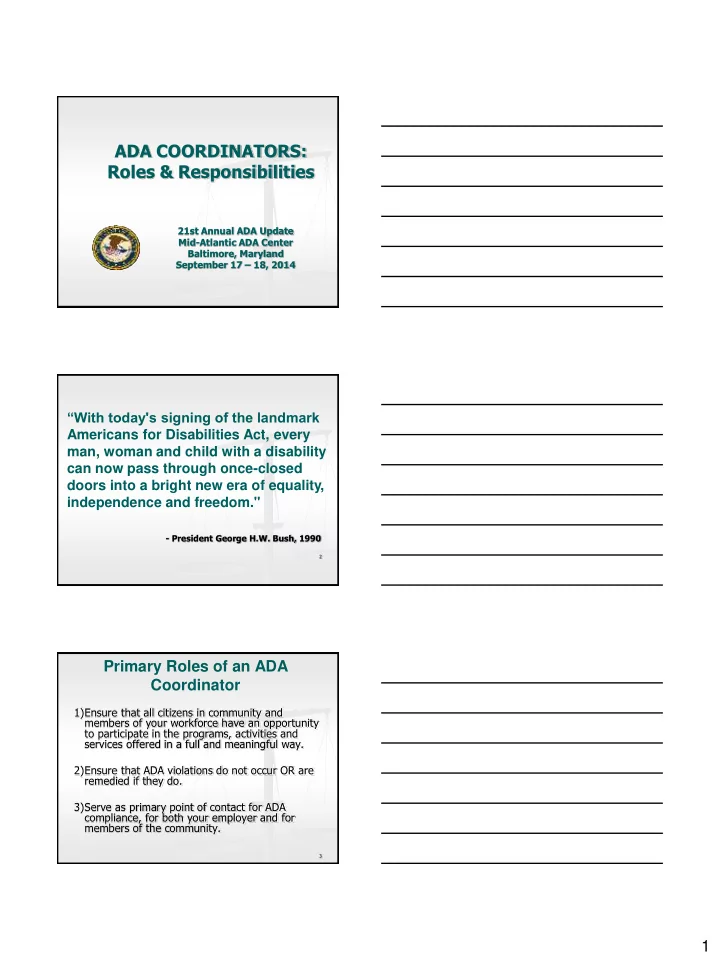

ADA COORDINATORS: Roles & Responsibilities 21st Annual ADA Update Mid-Atlantic ADA Center Baltimore, Maryland September 17 – 18, 2014 “With today's signing of the landmark Americans for Disabilities Act, every man, woman and child with a disability can now pass through once-closed doors into a bright new era of equality, independence and freedom." - President George H.W. Bush, 1990 2 Primary Roles of an ADA Coordinator 1) Ensure that all citizens in community and members of your workforce have an opportunity to participate in the programs, activities and services offered in a full and meaningful way. 2) Ensure that ADA violations do not occur OR are remedied if they do. 3) Serve as primary point of contact for ADA compliance, for both your employer and for members of the community. 3 1
Some Important Questions Where do you fit in the hierarchy? Do you report directly to the Mayor or Town Manager? Do you report to the Human Resources Director? Do you report to a mid-level administrator? Do you report to anyone? 4 More Important Questions Whose ear do you have? Consider other departments as well as management. Whose ear do you need? Same as above. 5 Basic Principles Equal opportunity Integration Inclusion in planning 6 2
Integration Mandate Must give priority to methods that provide services, programs, and activities in the most integrated setting appropriate. What Does the Law Say We Have to Do? General Rules Sec. 202 [42 U.S.C. 12132] DISCRIMINATION Subject to the provisions of this title, no qualified individual with a disability shall, by reason of such disability, be excluded from participation in or be denied the benefits of the services, programs, or activities of a public entity, or be subjected to discrimination by any such entity. 9 3
§ 35.130(a) General prohibitions against discrimination No qualified individual with a disability shall, on the basis of disability, be excluded from participation in or be denied the benefits of the services, programs, or activities of a public entity, or be subjected to discrimination by any public entity. 10 Administrative Requirements {35.107 Designation of responsible employee and adoption of grievance procedures. 1. (a) Designation of responsible employee. A public entity that employs 50 or more persons shall designate at least one employee to coordinate its efforts to comply with and carry out its responsibilities under this part, including any investigation of any complaint communicated to it alleging its noncompliance with this part or alleging any actions that would be prohibited by this part. 11 Administrative Requirements The public entity shall make available to all interested individuals the name, office address, and telephone number of the employee or employees designated pursuant to this paragraph. 12 4
Administrative Requirements: Grievance Procedure (b) Complaint procedure. A public entity that employs 50 or more persons shall adopt and publish grievance procedures providing for prompt and equitable resolution of complaints alleging any action that would be prohibited by this part. 13 Where Does it Say That??? A. Statute: 42 United States Code § 12101 et seq. Enacted by Congress - the law itself; States broad principles of the law; Charges enforcement agencies with developing implementing regulations; Outlines purpose of the law and cites Congressional findings justifying the need for the law. 14 Where Does it Say That??? B. 28 CFR Part 35 (Implementing Regulations) Provides specific rules for compliance with the law; Outlines more specific enforcement provisions; “Operating manual”. 15 5
Where Does it Say That??? C. Technical Assistance Manuals Provides guidance in carrying out compliance responsibilities; Non-legal, written in practical, example-driven manner; Not enforceable, but courts have historically given deference to agency’s interpretations contained in the manuals. D. Technical Assistance Materials 16 Questions to Ask (and Answer) Understand your agency’s programs, activities and services: What are they? What are they intended to do? Why are they carried out or delivered in the manner they are? What is the underlying purpose of them? What, if any, eligibility requirements exist for each program? Are they necessary? Assess institutional commitment - does one exist? Can it be built? 17 More Questions to Ask Know who has responsibility for what. What are YOUR responsibilities? Who has responsibilities for program access, policy, and facilities issues? EEO? Do we have an ADA Coordinator? Do we have a grievance procedure? 18 6
Where Do I Go From Here? Understand the requirements of the ADA. Don’t be afraid to ask and use resources. There are NO stupid questions . Never, ever be afraid to say “I don’t know” to anyone. Always promise to get back to them. Set realistic, achievable timeframes for all your activities. Don’t set yourself up for failure. 19 Where Do I Go From Here? Respond to inquiries, complaints, or compliments (they will come!) in a timely manner - even if you don’t know what the answer is. Outline realistic, clear, and measurable steps, including time lines, in your grievance procedure and adhere to them. Don’t EVER be afraid to ask questions or say you don’t know the answer or to ask questions. Nobody knows the answer to every question! Where Do I Go From Here? Develop your own support network. Developing relationships is important: With the people at this conference and in this room. Chances are they have experienced what you are dealing with and have some good suggestions. You don’t have to feel alone. Reach out and develop relationship with the disability community in your area. They can identify priorities, help to develop a realistic compliance plan, and provide other valuable input. 21 7
Where Do I Go From Here? Contact and develop relationships with designated Federal agencies — they can be your friend. CALL US! Keep DOJ and the ADA Network phone numbers with you at all times. You can do this! 22 Resources Regulations, appendices, standards are available at DOJ’s ADA web site at www.ada.gov . For answers to specific questions, DOJ toll-free confidential ADA information line: 800-514-0301 (Voice) 800-514-0383 (TTY) Mid-Atlantic ADA Center: 800-949-4232 (Voice/TTY) www.adata.org 23 8
Recommend
More recommend